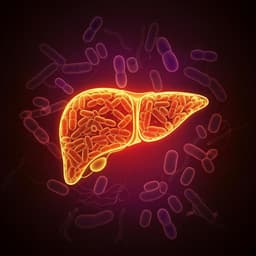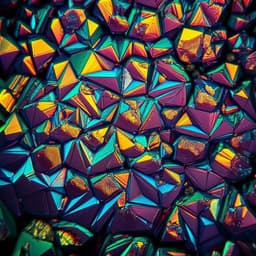
Engineering and Technology
High-performance piezoelectric energy harvesting in amorphous perovskite thin films deposited directly on a plastic substrate
J. Han, S. H. Park, et al.
Discover groundbreaking advancements in flexible amorphous thin-film energy harvesters utilizing perovskite CaCu3Ti4O12 (CCTO) thin films on plastic substrates, resulting in an impressive output voltage of -38.7 V and power density of -2.8 × 106 μW cm-3. This innovative research was conducted by Ju Han, Sung Hyun Park, Ye Seul Jung, and Yong Soo Cho.
~3 min • Beginner • English
Introduction
The study addresses the challenge of achieving high-performance piezoelectric energy harvesting in flexible formats without the high-temperature crystallization and complex transfer processes required by conventional perovskite oxide thin films (e.g., PZT, (K,Na)NbO3, (Bi,Na)TiO3) typically grown on rigid substrates above ~700 °C. Flexible systems enable bending, stretching, and warping inputs but are incompatible with such high-temperature processing, leading to reliance on film transfer methods (mica exfoliation, Si wet etching, laser lift-off, stress-driven exfoliation). The authors propose directly sputtering amorphous perovskite CaCu3Ti4O12 (CCTO) thin films at room temperature onto plastic substrates to realize bend-driven electromechanical energy conversion. Although crystalline/polycrystalline CCTO is known for colossal dielectric permittivity stemming from interfacial (Maxwell–Wagner) polarization and has indications of ferroelectricity, the polarization mechanism in amorphous CCTO differs. Prior evidence in other amorphous perovskites suggests local TiO6 dipolar polarization can persist without long-range order. The research tests whether amorphous CCTO can provide significant piezoelectric response and harvesting performance, and investigates how stoichiometry, oxygen partial pressure, and defect chemistry govern the electromechanical behavior.
Literature Review
- Conventional thin-film harvesters rely on crystalline perovskite oxides (PZT, (K,Na)NbO3, (Bi,Na)TiO3) grown at >700 °C on rigid substrates; flexible devices typically require complicated film transfer to polymers (mica exfoliation, Si wet etching, laser lift-off, stress-driven exfoliation).
- Polycrystalline CCTO exhibits colossal dielectric constant (εr > 10^5) stable from 100–600 K, often explained by Maxwell–Wagner interfacial polarization across semiconducting grains and insulating grain boundaries (internal barrier layer capacitor model), with defect chemistry and mixed cation valence states playing key roles.
- Amorphous perovskite oxides (e.g., BaTiO3, SrTiO3) can display enhanced Ti off-centering and piezo/pyroelectricity via local polar units consistent with random network of local bonding units (RN-LBU) theory, despite lacking long-range periodicity. Reported effective PFM piezo-coefficients for amorphous films include ~16 pm V^-1 (KNbO3, 300 nm) and ~10 pm V^-1 (SrTiO3, 100 nm).
- Prior work on amorphous CCTO sputtered at room temperature showed high εr (~192) among amorphous oxides and utility as high-k dielectric in thin-film transistors; defect-dependent chemical states and short-range grain boundary-like features were implicated in its permittivity.
- Reported thin-film harvesters across materials (PZT, KNN, BNT, ZnO, AlN, halide perovskites) use vibration, pressing, or bending. Best-in-class thin-film PZT cantilevers (2.8 μm) achieved ~244 μW and 1.1 × 10^6 μW cm^-3 at resonance, while flexible MAPbI3 (486 nm) achieved ~182 μW and 2.7 × 10^5 μW cm^-3 by bending. Polymer-matrix composite harvesters can deliver high outputs but generally lower power densities than reported here.
Methodology
- Film deposition: Amorphous CaCu3Ti4O12 (CCTO) thin films sputtered at room temperature by RF magnetron sputtering (2-inch stoichiometric target prepared via solid-state reaction at 1000 °C, hot-pressed at 1100 °C, 15 MPa). Substrates: Pt (~100 nm)/PEN (~125 μm). Working pressure 7.2 mTorr, RF power 100 W, target–substrate distance 7 cm, rotating holder (8 rpm). Oxygen partial pressure pO2 varied from 1.8 to 4.0 mTorr via Ar/O2 flow (e.g., 4.0 mTorr from Ar/O2 = 30/38 sccm). Thickness varied ~86–~497 nm by sputter time up to ~177 min.
- Device structure: Flexible harvester stack PEN/ITO/PDMS/CCTO/Pt/PEN; top PEN ~50 μm, bottom PEN ~125 μm; effective device area 3 cm^2. PDMS (Sylgard 184, 10 wt% curing agent) spin-coated on 50 μm ITO/PEN at 4000 rpm for 60 s, pre-cured 120 °C for 5 min, then bonded to CCTO and cured at 120 °C for 30 min. Cu wires connected to exposed Pt; both sides passivated with PI tape. Neutral plane positioning and bending strain estimation provided (Supplementary Note 1).
- Characterization: TEM (cross-section, diffraction) and XRD to confirm amorphous phase across thicknesses and pO2. High-resolution XPS (Cu 2p3/2, Ti 2p3/2, O 1s) to quantify valence states and oxygen vacancies; stoichiometry estimated from peak areas. PFM (AC 4 V at 40 kHz) to obtain PR amplitude/phase maps; DC bias sweeps (±10 V); d33,eff mapping over 10 × 10 μm^2 (400 points); ferroelectric domain switching by writing ±10 V. Dielectric spectroscopy (10^2–10^6 Hz). Complex impedance (Nyquist) to resolve interfacial and grain-boundary-like contributions. Laser interferometry (single-beam) to estimate effective d33 on films grown on Si; four-point bender to measure e31,eff (films on Si).
- Harvesting measurements: Periodic bending using a one-axis fatigue machine; bending strain 0.45–0.77% and frequency 0.86–3.50 Hz. Output voltage measured with 10 MΩ input nanovoltmeter; current with 1 MΩ galvanostat. Load resistance varied 10^2–10^10 Ω to determine power and power density. Stability assessed up to 11,000 bending cycles. Humidity stability probed (30–80% RH). Poling: applied electric fields up to 120 kV cm^-1 to enhance polarization and harvesting output.
Key Findings
- Structural/chemical: All CCTO films remained amorphous across thicknesses (~86–497 nm) and pO2 (1.8–4.0 mTorr). XPS showed mixed valence states with pO2-dependent trends: Cu2+/Cu+ and Ti4+/Ti3+ ratios increased with pO2; oxygen vacancy (Ov) fraction decreased. Near-stoichiometric composition (Ca:Cu:Ti:O ≈ 1.00:3.01:3.99:12.00) achieved at 4.0 mTorr.
- Piezoelectric response: PFM revealed stronger piezoresponse with higher pO2; average d33,eff increased from 1.73 ± 0.3 pm V^-1 (1.8 mTorr) to 27.6 ± 4.4 pm V^-1 (4.0 mTorr). Ferroelectric-like domain switching observed by alternating ±10 V writes. Laser interferometry on Si substrates yielded effective d33 ≈ -28.5 pm V^-1 (4.0 mTorr) vs -18.1 pm V^-1 (3.0 mTorr). Transverse e31,eff ≈ -1.1 C m^-2 (4.0 mTorr).
- Dielectric properties: εr increased with pO2 over 10^2–10^6 Hz; e.g., ~158 at 10^3 Hz for 4.0 mTorr vs ~21 at 1.8 mTorr. Clear dielectric resonance near 10^5 Hz consistent with dipolar (ferroelectric) polarization; strong upturn toward low frequency attributed to interfacial (space-charge) polarization. Impedance spectra (3.0 and 4.0 mTorr) showed two arcs indicating grain-boundary-like and electrode-interface resistances; higher pO2 reduced interfacial resistance; first arc magnitude (~kΩ) comparable to reported grain boundary resistance in polycrystalline CCTO.
- Harvesting performance (bending mode): Outputs strongly depended on pO2 and thickness. For ~497 nm films at 0.77% strain and 3.10 Hz: voltage/current increased from ~-4.5 V/-273 nA (1.8 mTorr) to ~-22.0 V/-906 nA (4.0 mTorr) without poling. Thicker films improved outputs; compared to ~86 nm, ~497 nm yielded ~368% higher peak voltage and ~597% higher peak current. Optimal bending conditions: 0.77% strain, 3.10 Hz. Stable performance over ≥11,000 cycles; negligible contribution from PDMS alone (~-0.05 V, -17 nA).
- Poling effect: Applying up to 120 kV cm^-1 enhanced outputs to peak -38.7 V and -1.24 μA; load optimization gave maximum power ~413 μW at ~10^6 Ω. Estimated power density reached ~2.8 × 10^6 μW cm^-3.
- Figure of merit: FOM = d33 × g33 improved markedly with pO2, from 0.06 × 10^-12 to 1.22 × 10^-12 m^2 N^-1 at 4.0 mTorr, reflecting higher d33 and manageable εr.
- Benchmarking: Reported outputs (413 μW, 2.8 × 10^6 μW cm^-3) exceed those of prior thin-film piezoelectric harvesters (including resonant PZT cantilevers and flexible halide perovskite films) and are superior to polymer-matrix composite harvesters in power density.
Discussion
Directly sputtered amorphous CCTO thin films on plastic substrates demonstrate that strong electromechanical energy conversion can be achieved without crystalline growth or transfer steps. The enhanced harvesting with higher pO2 correlates with improved stoichiometry, reduced oxygen vacancies, and altered cation valence states, which together strengthen local TiO6 dipolar polarization (short-range ordered dipoles per RN-LBU theory) and reduce interfacial losses. Defect dipoles (Ti3+-VO and Cu+/Cu2+-VO) contribute additional interfacial polarization; impedance spectra indicate short-range boundary-like features even in the amorphous state. While increased polarization may raise εr (which can reduce voltage coefficient g33), the overall figure of merit improves due to substantial gains in d33 and controlled εr. Thickness and mechanical parameters (strain, frequency) further optimize conversion, and poling aligns permanent and defect dipoles to maximize performance. Compared with vibration-based crystalline thin-film cantilevers, the bending-driven amorphous devices provide record power and power density with excellent mechanical durability, highlighting a new pathway for flexible, high-performance energy harvesters based on perovskite oxides.
Conclusion
The work establishes amorphous perovskite CCTO thin films, sputtered at room temperature directly onto plastic substrates, as a high-performance platform for flexible piezoelectric energy harvesting. Nearly stoichiometric films (high pO2) exhibit strong local dipolar polarization and favorable interfacial characteristics, delivering record outputs under bending: up to -38.7 V, 413 μW, and ~2.8 × 10^6 μW cm^-3 after poling, with stable operation over >11,000 cycles. The results outperform previously reported thin-film oxide and halide harvesters and obviate complex film transfer processes. Future research could explore broader amorphous perovskite chemistries, systematic defect/stoichiometry engineering to optimize the balance between d33 and εr, refined metrology for intrinsic piezo coefficients, long-term environmental stability, and integration into wearable or self-powered electronics.
Limitations
- Reported piezoelectric coefficients are effective values with known uncertainties: PFM-based d33,eff may deviate from intrinsic values due to instrument limitations; single-beam laser interferometry on films on Si can include uncompensated substrate bending effects.
- Maximum harvesting performance relies on electrical poling; unpoled devices produce lower (though still high) outputs.
- Dielectric enhancement via interfacial polarization can increase εr, potentially reducing g33; balancing these competing effects requires careful stoichiometry/defect control.
Related Publications
Explore these studies to deepen your understanding of the subject.







